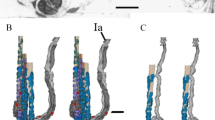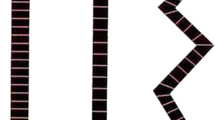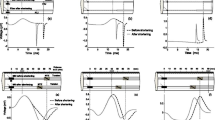Abstract
To investigate the effects of eccentric exercise on the signalling properties of muscle spindles, experiments were done using the medial gastrocnemius muscle of cats anaesthetised with 40 mg/kg sodium pentobarbitone, i.p. Responses were recorded from single afferent nerve fibres in filaments of dorsal root during slow stretch of the passive muscle and during intrafusal contractions at a range of lengths, before and after a series of eccentric contractions. The sensitivity to slow stretch was measured as the average firing rate between muscle lengths 10.5 and 9.5 mm shorter than the physiological maximum (L m ), during stretch at 1 mm/s over the whole physiological range. The mean sensitivity of both primary and secondary spindle endings increased slightly, but not significantly, after a series of 20–150 eccentric contractions consisting of a 6 mm stretch, at 50 mm/s, to a final length of between L m −7 mm and L m , during stimulation of the whole muscle or sometimes of single fusimotor fibres. Discharges were recorded from primary endings during fusimotor stimulation at 100–150 pulses/s, and from secondary endings during static bag intrafusal contractures produced by i.v. injection of 0.2 mg/kg succinyl choline. Spindle responses were recorded, over a range of muscle lengths, in steps covering the whole physiological range. About half of the responses showed a peak in the relation between length and net increase in firing rate, while the remainder either progressively increased or progressively decreased over the physiological range. No large or consistent changes were seen after the eccentric contractions. It is concluded that the intrafusal fibres of muscle spindles are not prone to damage of the kind seen in extrafusal fibres after a series of eccentric contractions.





Similar content being viewed by others
References
Barker D (1974) The morphology of muscle receptors. In: Hunt CC (ed) Handbook of sensory physiology, vol. III, part 2. Springer, Berlin, pp 1–190
Bessou P, Pages B (1972) Intracellular potentials from intrafusal muscle fibers evoked by stimulation of static and dynamic fusimotor axons in the cat. J Physiol 227:709–727
Bessou P, Laporte Y, Pages B (1968) Frequencygrams of spindle primary endings elicited by stimulation of static and dynamic fusimotor fibres. J Physiol 196:47–63
Boyd IA (1985) Internal working of muscle spindles—review. In: Boyd IA, Gladden MH (eds) The muscle spindle. MacMillan, London, pp 129–150
Brockett C, Warren N, Gregory JE, Morgan DL, Proske U (1997) A comparison of the effects of concentric versus eccentric exercise on force and position sense at the human elbow joint. Brain Res 771:251–258
Brockett CL, Morgan DL, Proske U (2001) Human hamstring muscles adapt to eccentric exercise by changing optimum length. Med Sci Sports Exerc 33:783–790
Burke RE, Levine DN, Zajac FE, 3rd (1971) Mammalian motor units: physiological-histochemical correlation in three types in cat gastrocnemius. Science 174:709–712
Carson RG, Riek S, Shahbazpour N (2002) Central and peripheral mediation of human force sensation following eccentric or concentric contractions. J Physiol 539:913–925
Gandevia SC (1996) Kinesthesia: roles for afferent signals and motor commands. In: Rowell LB, Shepherd JT (eds) Handbook on integration of motor, circulatory, respiratory and metabolic control during exercise. American Physiological Society, Bethesda, MD, pp 128–172
Gregory JE, Morgan DL, Proske U (1988) Responses of muscle spindles depend on their history of activation and movement. Prog Brain Res 74:85–90
Gregory JE, Brockett CL, Morgan DL, Whitehead NP, Proske U (2002) Effect of eccentric muscle contractions on Golgi tendon organ responses to passive and active tension in the cat. J Physiol 538:209–218
Gregory JE, Morgan DL, Proske U (2003) Tendon organs as monitors of muscle damage from eccentric contractions. Exp Brain Res 151:346–355
Jones C, Allen T, Talbot J, Morgan DL, Proske U (1997) Changes in the mechanical properties of human and amphibian muscle after eccentric exercise. Eur J Appl Physiol Occup Physiol 76:21–31
Matthews PBC (1962) The differentiation of two types of fusimotor fibre by their effects on the dynamic response of muscle spindle primary endings. Q J Exp Physiol 47:324–333
Matthews PBC (1988) Proprioceptors and their contributions to somatosensory mapping: complex messages require complex processing. Can J Physiol Pharmacol 66:430–438
McCloskey DI (1978) Kinesthetic sensibility. Physiol Rev 58:763–820
McCloskey DI (1981) Corollary discharges: motor commands and perception. In: Brooks VB (ed) Handbook of physiology. The nervous system, motor control. American Physiological Society, Bethesda, MD, pp 1415–1447
Morgan DL (1990) New insights into the behavior of muscle during active lengthening. Biophys J 57:209–221
Morgan DL, Whitehead NP, Wise AK, Gregory JE, Proske U (2000) Tension changes in the cat soleus muscle following slow stretch or shortening of the contracting muscle. J Physiol 522:503–513
Paillard M, Brouchon M (1968) Active and passive movements in the calibration of position sense. In: Freedman SJ (ed) The neuropsychology of spatially oriented behaviour. Dorsey Press, Homewood, IL, pp 37–55
Proske U (1993) The golgi tendon organ. In: Dyck PJ, Thomas PK (eds) Peripheral neuropathy, vol 1. WB Saunders, Philadelphia, pp 141–148
Proske U (1997) The mammalian muscle spindle. News Physiol Sci 12:37–42
Proske U, Morgan DL (2001) Muscle damage from eccentric exercise: mechanism, mechanical signs, adaptation and clinical applications. J Physiol 537:333–345
Proske U, Waite PM (1974) Properties of types of motor units in the medial gastrocnemius muscle of the cat. Brain Res 67:89–101
Proske U, Schaible HG, Schmidt RF (1988) Joint receptors and kinaesthesia. Exp Brain Res 72:219–224
Proske U, Morgan DL, Gregory JE (1993) Thixotropy in skeletal muscle and in muscle spindles: a review. Prog Neurobiol 41:705–721
Saxton JM, Clarkson PM, James R, Miles M, Westerfer M, Clark S, Donnelly AE (1995) Neuromuscular dysfunction following eccentric exercise. Med Sci Sports Exerc 27:1185–1193
Taylor A, Morgan DL, Gregory JE, Proske U (1994) The responses of secondary endings of cat soleus muscle spindles to succinyl choline. Exp Brain Res 100:58–66
Vallbo A (1974) Human muscle spindle discharge during isometric voluntary contractions. Amplitude relations between spindle frequency and torque. Acta Physiol Scand 90:319–336
Walsh LD, Hesse CW, Morgan DL, Proske U (2004) The role of effort in position sense. Proceedings of the Australian Neuroscience Society, Satellite Symposium on Motor Control, Melbourne, p 2
Weerakkody NS, Percival P, Morgan DL, Gregory JE, Proske U (2003) Matching different levels of isometric torque in elbow flexor muscles after eccentric exercise. Exp Brain Res 149:141–150
Whitehead NP, Weerakkody NS, Gregory JE, Morgan DL, Proske U (2001) Changes in passive tension of muscle in humans and animals after eccentric exercise. J Physiol 533:593–604
Whitehead NP, Morgan DL, Gregory JE, Proske U (2003) Rises in whole-muscle passive tension of mammalian muscle after eccentric contractions at different muscle lengths. J Appl Physiol 95:1224–1234
Author information
Authors and Affiliations
Corresponding author
Rights and permissions
About this article
Cite this article
Gregory, J.E., Morgan, D.L. & Proske, U. Responses of muscle spindles following a series of eccentric contractions. Exp Brain Res 157, 234–240 (2004). https://doi.org/10.1007/s00221-004-1838-9
Received:
Accepted:
Published:
Issue Date:
DOI: https://doi.org/10.1007/s00221-004-1838-9




